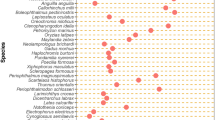Abstract
We characterized five transposable elements from fish: one from zebrafish (Brachydanio rerio), one from rainbow trout (Salmo gairdneri), and three from Atlantic salmon (Salmo salar). All are closely similar in structure to the Tel transposon of the nematode Caenorhabditis elegans. A comparison of 17 Tc1-like transposons from species representing three phyla (nematodes, arthropods, and chordates) showed that these elements make up a highly conserved transposon family. Most are close to 1.7 kb in length, have inverted terminal repeats, have conserved terminal nucleotides, and each contains a single gene encoding similar poly peptides. The phylogenetic relationships of the transposons were reconstructed from the amino acid sequences of the conceptual proteins and from DNA sequences. The elements are highly diverged and have evidently inhabited the genomes of these diverse species for a long time. To account for the data, it is not necessary to invoke recent horizontal transmission.
Similar content being viewed by others
References
Brezinsky L, Wang GVL, Humphreys T, Hunt J (1990) The transposable element Uhu from Hawaiian Drosophila — member of the widely dispersed class of Tc1-like transposons. Nucleic Acids Res 18:2053–2059
Brierly HL, Potter SS (1985) Distinct characteristics of loop sequences of two Drosophila foldback transposable elements. Nucleic Acids Res 13:485–500
Caizzi R, Caggese C, Pimpinelli S (1993) Bari-1, a new transposon-like family in Drosophila melanogaster with a unique heterochromatic organization. Genetics 133:335–345
Calvi BR, Hong TJ, Findley SD, Gelbart WM (1991) Evidence for a common evolutionary origin of inverted repeat transposons in Drosophila and plants: hobo, Activator, and Tam3. Cell 66:465–471
Collins J, Forbes E, Anderson P (1989) The Tc3 family of transposable genetic elements in Caenorhabditis elegans. Genetics 121:47–55
Devereux J, Haeberli P, Smithies O (1984) A comprehensive set of sequence analysis probrams for the VAX. Nucleic Acids Res 12:387–395
Di Nocera PP, Sakaki Y (1990) LINEs: a superfamily of retrotrans-posable ubiquitous DNA elements. Trends Genet 6:29–30
Dreyfus DH, Emmons SW (1991) A transposon-related palindromic repetitive sequence from C. elegans. Nucleic Acids Res 19:1871–1877
Eide D, Anderson P (1985) Transposition of Tc1 in the nematode C. elegans. Proc Natl Acad Sci USA 82:1756–1760
Finnegan DJ (1985) Transposable elements in eukaryotes. Int Rev Cytol 93:281–326
Franz G, Savakis C (1991) Minos, a new transposable element from Drosophila hydei, is a member of the Tc1-like family of transposons. Nucleic Acids Res 19:6646
Garcia-Fernandez J, Marfany G, Baguna J, Salo E (1993) Infiltration of mariner elements. Nature 364:109
Hedges SB (1992) The number of replications needed for accurate estimation of the bootstrap P value in phylogenetic studies. Mol Biol Evol 19:366–369
Heierhorst J, Lederis K, Richter D (1992) Presence of a member of the Tc1-like transposon family from nematodes and Drosophila within the vasotocin gene of a primitive vertebrate, the Pacific hagfish Eptatretus stouti. Proc Natl Acad Sci USA 89:6798–6802
Henikoff S (1992) Detection of Caenorhabditis transposon homologs in diverse organisms. New Biologist 4:382–388
Henikoff S, Henikoff JG (1992) Amino acid substitution matrices from protein blocks. Proc Natl Acad Sci USA 89:10915–10919
Higgins DG, Sharp PM (1988) CLUSTAL: a package for performing multiple sequence alignment on a microcomputer. Gene 73:237–244
Jukes TH, Cantor CR (1969) In: Munro HN, (ed) Mammalian protein metabolism. Academic Press, London, pp 21–123
Kidwell MG (1992) Horizontal transfer. Curr Opin Genet Dev 2:868–873
Kimura M (1980) A simple method for estimating evolutionary rates of base substitutions through comparative studies of nucleotide sequences. J Mol Evol 16:111–120
Maniatis T, Fritsch EF, Sambrook J (1982) Molecular cloning. A laboratory manual. Cold Spring Harbor Laboratory Press, Cold Spring Harbor, NY
Moerman DG, Benian GM, Waterston RH (1986) Molecular cloning of the muscle gene unc-22 in Caenorhabditis elegans by Tel transposon tagging. Proc Natl Acad Sci USA 83:2579–2583
Prasad SS, Harris LJ, Baillie DL, Rose AM (1991) Evolutionarily conserved regions in Caenorhabditis transpoable elements deduced by sequence comparison. Genome 34:6–12
Robertson HM (1993a) The mariner transposable element is widespread in insects. Nature 362:241–245
Robertson HM (1993b) Infiltration of mariner elements. Nature 364:109–110
Rosenzweig B, Liao L, Hirsh D (1983) Sequence of the C. elegans transposable element Tel. Nucleic Acids Res 11:4201–4209
Rushforth AM, Saari B, Anderson P (1993) Site-selected insertion of the transposon Tel into a Caenorhabditis elegans myosin light chain gene. Mol Cell Biol 13:902–910
Rzhetsky A, Nei M (1992) A simple method for estimating and testing minimum-evolution trees. Mol Biol Evol 9:945–967
Saiki RK, Gelfand DH, Stoffel S, Scharf SJ, Higuchi R, Horn GT, Mullis KB, Erlich HA (1988) Primer-directed enzymatic amplification of DNA with a thermostable DNA polymerase. Science 239:487–491
Saitou N, Nei M (1987) The neighbor-joining method: a new method for reconstructing phylogenetic trees. Mol Biol Evol 4:406–425
Schukkink RF, Plasterk RHA (1990) TcA, the putative transposase of the C. elegans Tc1 transposon, has an N-terminal DNA-binding domain. Nucleic Acids Res 18:895–900
Swofford DL (1991) Phylogenetic analysis using parsimony. Illinois Natural History Survey, Champaign, Illinois, USA
Swofford DL, Olsen GJ (1990) Phylogeny reconstruction. In: Hillis DM, Moritz C (eds) Molecular systematics. Sinauer, Sunderland, Mass., USA, pp 411–501
Vos JC, van Luenen HGAM, Plasterk RHA (1993) Characterization of the Caenorhabditis elegans Tc1 transposase in vivo and in vitro. Genes Dev 7:1244–1253
Voytas DF, Cummings MP, Konieczny A, Ausubel FM, Rodermel SR (1992) copia-like retrotransposons are ubiquitous among plants. Proc Natl Acad Sci USA 89:7124–7128
Author information
Authors and Affiliations
Additional information
Communicated by D. Finnegan
Rights and permissions
About this article
Cite this article
Radice, A.D., Bugaj, B., Fitch, D.H.A. et al. Widespread occurrence of the Tc1 transposon family: Tc1-like transposons from teleost fish. Molec. Gen. Genet. 244, 606–612 (1994). https://doi.org/10.1007/BF00282750
Received:
Accepted:
Issue Date:
DOI: https://doi.org/10.1007/BF00282750




